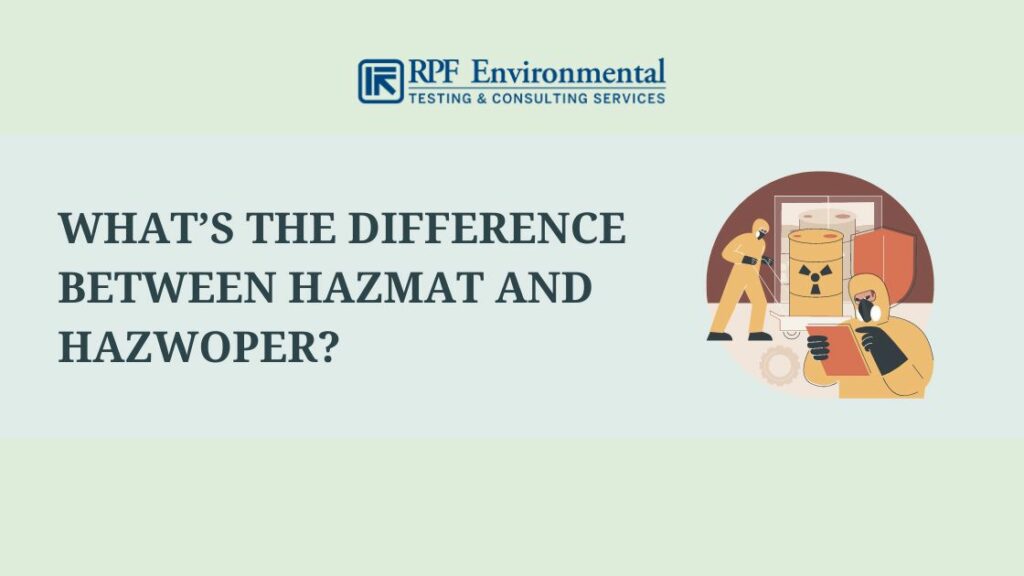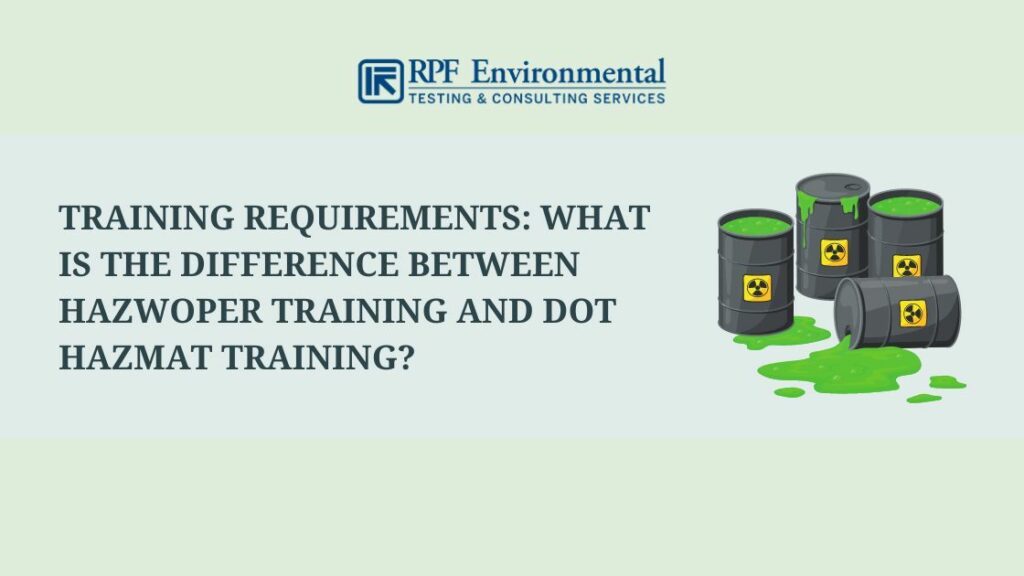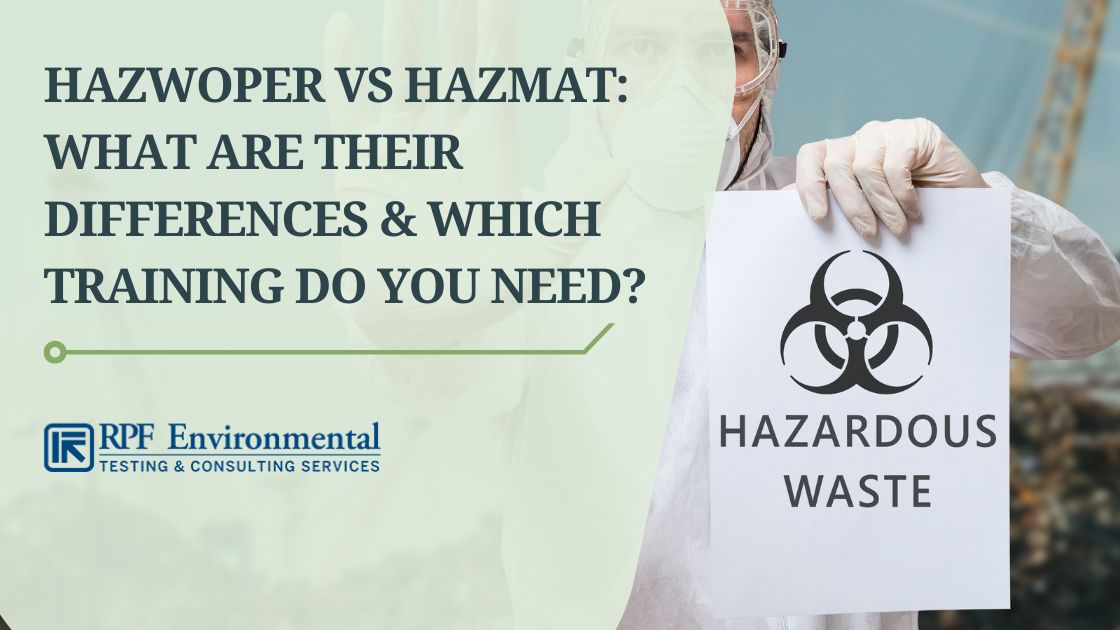The difference between Hazardous Materials (HAZMAT) and Hazardous Waste Operations and Emergency Response (HAZWOPER) can be confusing. But though similar, HAZWOPER and HAZMAT training are implemented by different agencies and cover different regulations.
In general, HAZWOPER training involves workers in clean-up activities, corrective actions, and emergency response operations in hazardous sites. On the other hand, HAZMAT training covers the transportation of hazardous materials. Keep reading to know more about HAZWOPER vs HAZMAT to ensure that you’re getting the right training.

We have licensed professionals in RPF Environmental offering HAZWOPER as well as HAZCOM training in Illinois, Indiana, Maine, Massachusetts, New Hampshire, and beyond. We also provide hazardous material surveys and other environmental health and safety training programs. Contact us now!
What’s the Difference Between HAZMAT and HAZWOPER?

The main difference between HAZWOPER and HAZMAT is that HAZWOPER is governed by OSHA while HAZMAT falls under DOT. But though HAZMAT covers hazardous materials in transit, there are still uncontrolled substances that require emergency response. This is where the two overlap.
What Is HAZWOPER?
The HAZWOPER standard, referred to as 29 CFR 1910.120, was developed by OSHA to protect individuals working in hazardous sites while on the job. OSHA regulates hazardous waste activities and emergency response services. These include proper handling, storage, transportation, clean-up, and disposal of hazardous substances.
What Is HAZMAT?
Since HAZMAT was mentioned a few times in the HAZWOPER standard, this might have caused confusion. But take note that people who mention HAZMAT training are most likely referring to DOT’s Hazardous Material Regulations (HMR) training. The HMR requirements aim to prevent or reduce HAZMAT incidents during air, water, or highway transportation through proper handling before, during, and after transit. This includes appropriate packaging.
Training Requirements: What is the Difference Between HAZWOPER Training and DOT HAZMAT Training?

HAZWOPER and HAZMAT training have different scopes. Below are the key differences between the two based on the covered personnel, training scope, and training duration:
1. Covered Personnel
Who Needs HAZWOPER Training?
HAZWOPER training is required for anyone who will be exposed to hazardous substances in their work. OSHA mentioned three general categories of workers, including management and supervisors, who will need HAZWOPER training:
- General on-site workers like laborers and equipment operators
- Workers at Treatment, Storage, and Disposal (TSD) facilities
- Emergency responders
Who Needs HAZMAT Training?
HAZMAT employers are required to train their HAZMAT employees. A HAZMAT employee is defined in the HMR as those who are directly involved in HAZMAT transportation safety such as:
- Owner-operator of motor vehicles transporting HAZMAT
- People who:
- Load, unload, or handle HAZMAT
- Design, manufacture, fabricate, inspect, test, recondition, repair, modify, or mark packaging used for transporting HAZMAT
- Prepare HAZMAT for transportation
- Are responsible for transporting HAZMAT
- Operate vehicle for HAZMAT transportation
2. Training Scope
Below are the hazardous substances and materials along with situations covered in HAZWOPER and HAZMAT training:
HAZWOPER Training Scope
Hazardous substances, as defined under section 1910.120(a)(3) of the HAZWOPER standard, refer to substances that can compromise the safety or health of employees. These include:
- Substances defined by the Comprehensive Environmental Response Compensation and Liability Act (CERCLA)
- Disease-causing agents including biological agents that can cause death and health complications
- Substances listed under HMR 172.101
- Hazardous wastes defined in 49 CFR 171.8 and 40 CFR 261.3
In addition, the following operations are covered under HAZWOPER training:
- Clean-up operations that involve hazardous substances
- Corrective actions at sites included in the Resource Conservation and Recovery Act of 1976 (RCRA)
- Uncontrolled hazardous waste site voluntary clean-ups
- Treatment, storage, and disposal (TSD) operations
- Emergency responses
Also, below are some topics that should be covered in a HAZWOPER training:
- Understanding hazardous substances and their risks along with identification
- Understanding radiological, chemical, and toxicological terminology and behavior
- Implementing emergency response plans, incident command systems, decontamination, confinement, containment, and control operations
- Understanding termination, operating, and hazard & risk assessment procedures and techniques
- Using personal protective equipment (PPE)
- Developing site safety and control plans
DOT HAZMAT Training Scope
For HAZMAT training, hazardous materials are defined by DOT as those including:
- Hazardous substances
- Hazardous wastes
- Elevated Temperature Material
- Marine Pollutants
- Materials listed in the Hazardous Materials Table
- Materials defined in the General Requirements for Shipments and Packagings
Examples are:
- Explosives
- Gasses
- Flammable liquids and solids
- Oxidizing substances and organic peroxides
- Poisonous and infectious substances
- Radioactive materials
- Corrosives
In addition, HAZMAT training requirements include the following:
- General awareness/familiarization training for providing familiarity with the HMR
- Function-specific training
- Safety training concerning methods for avoiding incidents and protecting employees from hazards
- Security awareness training to improve transportation security
- In-depth security training that includes security objectives, structures, procedures, and responsibilities
- Driver training
Moreover, other important aspects of HAZMAT training are identifying hazardous substances and proper packaging based on the material type.
3. Duration and Frequency of Training
Another major difference between HAZMAT and HAZWOPER is that HAZWOPER training has set specific numbers of training hours. On the other hand, the duration of HAZMAT training will depend on your role. Also, higher roles will most likely have longer training hours.
| HAZWOPER Training | HAZMAT Training |
|---|---|
| – New full-time employees need to take an initial 40-hour training – Occasional workers can take an initial 24-hour training – An 8-hour annual refresher training should be taken | – Initial training for new HAZMAT employees needs to be taken within 90 days of employment including those who changed job functions – Recurrent training should be taken at least once every three years |
HAZWOPER Training Levels
HAZWOPER also has different tiers for emergency responders that determine the type of training they should be taking.
- First Responder Awareness (FRA) Level
- First Responder Operations (FRO) Level
- Hazardous Materials Technician
- Hazardous Materials Specialist
- On-Scene Incident Commander
As mentioned, the HAZMAT training duration doesn’t have a clearly-defined number of training hours. As for HAZWOPER’s FRA level, it only requires minimal training and most of the tiers will require at least a 24-hour training and an annual 8-hour refresher.
Also, HAZMAT training completion often means you need to take multiple courses due to the different training requirements. But while some online training platforms offer standalone courses, there are also those that combine multiple topics into one for supervisors who take on multiple roles.
FAQs
If you are HAZWOPER-certified, you are allowed to take part in activities involving hazardous substances without violating OSHA’s regulations. It also ensures that you perform your responsibilities without endangering yourself and other people.
HAZWOPER is a standard developed by OSHA, so they are closely related. Also, when people say “OSHA 40”, they’re likely referring to the 40-hour OSHA HAZWOPER training. This type of training is intended for new full-time workers who will be exposed to hazardous substances.
HAZWOPER 40-hour training is a required OSHA training that covers several important topics that ensure your safety while on the job. It includes OSHA regulations, identification and proper handling of hazardous substances, PPE usage, safe work practices, implementation of emergency response plans, and others.
OSHA HAZWOPER 40, including HAZWOPER 20-hour training, is only valid for 12 months. You need to take an 8-hour refresher training yearly to keep your certification. Failure to do so might require you to retake the training.
Conclusion
HAZWOPER and HAZMAT are similar policies that have been causing confusion to many people. Making sure that you understand their differences will guarantee that you will be choosing the right training appropriate for your role. It also ensures compliance with regulations regarding the proper handling of hazardous substances.
Reach out to us now for HAZWOPER training services in the New England region and beyond including Maine, New Hampshire, and Boston. We offer various environmental health and safety training programs along with hazardous material surveys. Contact us now!




